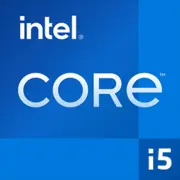Intel Core i5-4570S

Intel Core i5-4570S: A Comprehensive Review of an Outdated Yet Relevant Budget PC Solution (2025)
Haswell Architecture in the Age of AI and Quantum Computing — Is It Worth It?
1. Key Specifications: The "Heart" of a Budget System
The Intel Core i5-4570S processor, released in 2013, is still found on the secondary market and in office builds. Let’s examine its key parameters:
- Architecture: Haswell (4th generation Intel Core).
- Manufacturing Process: 22nm — a breakthrough for 2013, but today even budget chips are produced on 7-10nm processes.
- Cores/Threads: 4 cores, 4 threads — the lack of Hyper-Threading limits multitasking capabilities.
- Base Frequency: 2.9 GHz, maximum in turbo mode — 3.6 GHz.
- Cache: L3 — 6 MB (sufficient for basic tasks, but inadequate for modern gaming).
- TDP: 65W — low power consumption for a desktop CPU.
- Integrated Graphics: Intel HD 4600 — supports 4K@60Hz via DisplayPort, but is weak for gaming (example: CS:GO on low settings — 40-50 FPS).
Key Features:
- Support for AVX2 instructions, enhancing performance in specific tasks (e.g., video encoding).
- Energy-saving technologies: Enhanced SpeedStep, Thermal Monitoring.
- Compatibility with Windows 10/11 (with limitations) and Linux.
2. Compatible Motherboards: Hunting for Relics
The processor uses the LGA1150 socket, which has long been discontinued. Current chipsets include:
- H81/B85: Budget boards with basic features (e.g., ASUS H81M-K). Supports up to 16 GB DDR3, SATA III, USB 3.0.
- H87/Z87: Advanced options with overclocking capability (only for “K” series processors). For instance, MSI Z87-G43.
Selection Considerations in 2025:
- New boards are not produced — look for remnants in warehouses or refurbished options (price: $50–80).
- Check the condition of VRM modules — older boards often suffer from bulging capacitors.
- Important: PCIe 3.0 x16 is supported, but this will become a "bottleneck" for modern graphics cards (e.g., RTX 4060).
3. Memory: DDR3 as a Historical Artifact
The i5-4570S only works with DDR3 (up to 1600 MHz). Supported configurations:
- Dual-channel mode — use two identical sticks for +15% performance.
- Maximum capacity: 32 GB (but motherboards rarely support more than 16 GB).
Issues in 2025:
- DDR3 has become obsolete: new applications are optimized for DDR4/DDR5.
- Price: 8 GB DDR3 — $25–30 (new modules, e.g., Kingston HyperX Fury).
4. Power Supply: Saving Without Extremes
With a TDP of 65W and no discrete graphics card, a 300–400W PSU will suffice (e.g., be quiet! System Power 10 400W, $45).
Recommendations for Builds with a Graphics Card:
- For RTX 3050 or RX 6600 — a PSU of 500–550W (Corsair CX550M, $60).
- Avoid cheap noname power supplies — stability is more important than saving $10–20.
5. Pros and Cons: Who Is It Suitable For, and Who Is It Not?
Pros:
- Low power consumption — ideal for a 24/7 PC (e.g., media server).
- Affordable price — new (if you can find it) — $60–80.
- Reliability — many units are still operational after 10 years of use.
Cons:
- No support for DDR4, PCIe 4.0, NVMe (only through adapters).
- Weak multi-threaded performance — lags behind even budget Ryzen 3 5300G (Geekbench 6 Multi-Core: 2458 vs 6800).
- Limited upgrades — the most you can add is an SSD and a GTX 1660 level graphics card.
6. Use Cases: Where Is the i5-4570S Still Relevant?
- Office Tasks: Word, Excel, browser with 10+ tabs — the processor can handle it, but 4 GB of RAM will be insufficient.
- Multimedia: Watching 4K video (hardware decoding through HD 4600), music streaming.
- Casual Gaming: Dota 2, GTA V (on medium settings, 1080p), indie projects.
- Hobby Projects: Retro gaming, DIY builds for learning.
Real Example: A user in Brazil built a PC using the i5-4570S and GTX 1650 to play Fortnite (720p, 60 FPS), spending $200.
7. Comparison with Competitors: Battle of Generations
- Intel Core i3-10100F (2020): 4 cores/8 threads, Geekbench 6 Multi-Core — 4800. Price for a new unit — $90. Conclusion: the i3-10100F is 50% more powerful.
- AMD Ryzen 3 3200G (2019): 4 cores/4 threads, Vega 8, supports DDR4. Best choice for upgrades.
- Intel Core i5-4570S vs. Apple M1: Comparison is not valid, but the M1 is 3-4 times faster in multi-threaded tasks.
8. Assembly Tips: How Not to Mess Up?
- SSD is a Must: Kingston A400 240 GB ($25) will eliminate system "lags."
- RAM — at least 8 GB: 2x4 GB DDR3 is optimal.
- Cooling: The stock cooler is sufficient, but for quiet operation consider the Deepcool GAMMAXX 400 ($20).
- Check BIOS: Update it for compatibility with Windows 11 (unofficial patches available).
9. Conclusion: Who Is the i5-4570S Suitable for in 2025?
This processor is a choice for:
- Enthusiasts on a Budget: Building a PC for $150–200 for basic tasks.
- Owners of Old Systems: Upgrade without replacing the motherboard.
- Retro Tech Enthusiasts: Nostalgic projects.
Alternative: If you need a new PC — consider the Intel N100 platform ($150) or a used Ryzen 5 3600 ($80).
Conclusion: The Intel Core i5-4570S in 2025 is not for everyone. But for specific tasks, it remains a viable tool, reminding us that even outdated hardware can still be useful.
Basic
CPU Specifications
Memory Specifications
GPU Specifications
Benchmarks
Compared to Other CPU
Share in social media
Or Link To Us
<a href="https://cputronic.com/cpu/intel-core-i5-4570s" target="_blank">Intel Core i5-4570S</a>